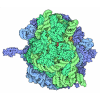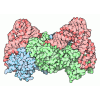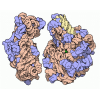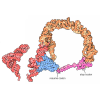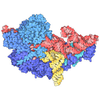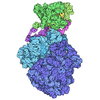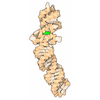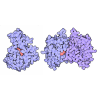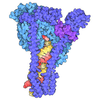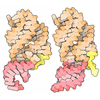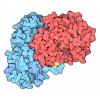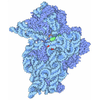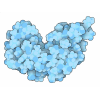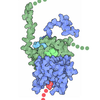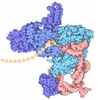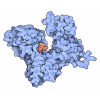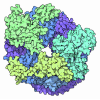+ Open data
Open data
- Basic information
Basic information
| Entry | Database: PDB / ID: 5a2q | |||||||||
|---|---|---|---|---|---|---|---|---|---|---|
| Title | Structure of the HCV IRES bound to the human ribosome | |||||||||
 Components Components |
| |||||||||
 Keywords Keywords | RIBOSOME / HUMAN RIBOSOME / HEPATITIS-C / IRES / TRANSLATION INITIATION | |||||||||
| Function / homology |  Function and homology information Function and homology informationexit from mitosis / optic nerve development / negative regulation of endoplasmic reticulum unfolded protein response / oxidized pyrimidine DNA binding / response to TNF agonist / positive regulation of base-excision repair / positive regulation of respiratory burst involved in inflammatory response / positive regulation of intrinsic apoptotic signaling pathway in response to DNA damage / positive regulation of gastrulation / protein tyrosine kinase inhibitor activity ...exit from mitosis / optic nerve development / negative regulation of endoplasmic reticulum unfolded protein response / oxidized pyrimidine DNA binding / response to TNF agonist / positive regulation of base-excision repair / positive regulation of respiratory burst involved in inflammatory response / positive regulation of intrinsic apoptotic signaling pathway in response to DNA damage / positive regulation of gastrulation / protein tyrosine kinase inhibitor activity / positive regulation of endodeoxyribonuclease activity / IRE1-RACK1-PP2A complex / nucleolus organization / positive regulation of Golgi to plasma membrane protein transport / retinal ganglion cell axon guidance / TNFR1-mediated ceramide production / negative regulation of DNA repair / negative regulation of RNA splicing / supercoiled DNA binding / neural crest cell differentiation / NF-kappaB complex / cysteine-type endopeptidase activator activity involved in apoptotic process / oxidized purine DNA binding / positive regulation of ubiquitin-protein transferase activity / negative regulation of intrinsic apoptotic signaling pathway in response to hydrogen peroxide / regulation of establishment of cell polarity / negative regulation of bicellular tight junction assembly / ubiquitin-like protein conjugating enzyme binding / negative regulation of phagocytosis / rRNA modification in the nucleus and cytosol / Formation of the ternary complex, and subsequently, the 43S complex / erythrocyte homeostasis / cytoplasmic side of rough endoplasmic reticulum membrane / laminin receptor activity / negative regulation of ubiquitin protein ligase activity / protein kinase A binding / ion channel inhibitor activity / Ribosomal scanning and start codon recognition / pigmentation / Translation initiation complex formation / positive regulation of mitochondrial depolarization / positive regulation of T cell receptor signaling pathway / negative regulation of Wnt signaling pathway / fibroblast growth factor binding / monocyte chemotaxis / positive regulation of activated T cell proliferation / negative regulation of translational frameshifting / TOR signaling / Protein hydroxylation / BH3 domain binding / SARS-CoV-1 modulates host translation machinery / regulation of adenylate cyclase-activating G protein-coupled receptor signaling pathway / iron-sulfur cluster binding / regulation of cell division / cellular response to ethanol / mTORC1-mediated signalling / Peptide chain elongation / Selenocysteine synthesis / Formation of a pool of free 40S subunits / positive regulation of intrinsic apoptotic signaling pathway by p53 class mediator / endonucleolytic cleavage to generate mature 3'-end of SSU-rRNA from (SSU-rRNA, 5.8S rRNA, LSU-rRNA) / Eukaryotic Translation Termination / ubiquitin ligase inhibitor activity / positive regulation of GTPase activity / Response of EIF2AK4 (GCN2) to amino acid deficiency / SRP-dependent cotranslational protein targeting to membrane / negative regulation of ubiquitin-dependent protein catabolic process / protein serine/threonine kinase inhibitor activity / positive regulation of signal transduction by p53 class mediator / Viral mRNA Translation / negative regulation of respiratory burst involved in inflammatory response / Nonsense Mediated Decay (NMD) independent of the Exon Junction Complex (EJC) / GTP hydrolysis and joining of the 60S ribosomal subunit / L13a-mediated translational silencing of Ceruloplasmin expression / Major pathway of rRNA processing in the nucleolus and cytosol / phagocytic cup / regulation of translational fidelity / Nonsense Mediated Decay (NMD) enhanced by the Exon Junction Complex (EJC) / negative regulation of protein binding / endonucleolytic cleavage in ITS1 to separate SSU-rRNA from 5.8S rRNA and LSU-rRNA from tricistronic rRNA transcript (SSU-rRNA, 5.8S rRNA, LSU-rRNA) / Protein methylation / Nuclear events stimulated by ALK signaling in cancer / positive regulation of intrinsic apoptotic signaling pathway / spindle assembly / laminin binding / rough endoplasmic reticulum / ribosomal small subunit export from nucleus / positive regulation of cell cycle / translation regulator activity / translation initiation factor binding / gastrulation / Amplification of signal from unattached kinetochores via a MAD2 inhibitory signal / DNA-(apurinic or apyrimidinic site) endonuclease activity / Maturation of protein E / signaling adaptor activity / Maturation of protein E / MDM2/MDM4 family protein binding / positive regulation of microtubule polymerization / ER Quality Control Compartment (ERQC) / Hsp70 protein binding Similarity search - Function | |||||||||
| Biological species |  HOMO SAPIENS (human) HOMO SAPIENS (human) HEPATITIS C VIRUS HEPATITIS C VIRUS | |||||||||
| Method | ELECTRON MICROSCOPY / single particle reconstruction / cryo EM / Resolution: 3.9 Å | |||||||||
 Authors Authors | Quade, N. / Leiundgut, M. / Boehringer, D. / Heuvel, J.v.d. / Ban, N. | |||||||||
 Citation Citation |  Journal: Nat Commun / Year: 2015 Journal: Nat Commun / Year: 2015Title: Cryo-EM structure of Hepatitis C virus IRES bound to the human ribosome at 3.9-Å resolution. Authors: Nick Quade / Daniel Boehringer / Marc Leibundgut / Joop van den Heuvel / Nenad Ban /   Abstract: Hepatitis C virus (HCV), a widespread human pathogen, is dependent on a highly structured 5'-untranslated region of its mRNA, referred to as internal ribosome entry site (IRES), for the translation ...Hepatitis C virus (HCV), a widespread human pathogen, is dependent on a highly structured 5'-untranslated region of its mRNA, referred to as internal ribosome entry site (IRES), for the translation of all of its proteins. The HCV IRES initiates translation by directly binding to the small ribosomal subunit (40S), circumventing the need for many eukaryotic translation initiation factors required for mRNA scanning. Here we present the cryo-EM structure of the human 40S ribosomal subunit in complex with the HCV IRES at 3.9 Å resolution, determined by focused refinement of an 80S ribosome-HCV IRES complex. The structure reveals the molecular details of the interactions between the IRES and the 40S, showing that expansion segment 7 (ES7) of the 18S rRNA acts as a central anchor point for the HCV IRES. The structural data rationalizes previous biochemical and genetic evidence regarding the initiation mechanism of the HCV and other related IRESs. | |||||||||
| History |
| |||||||||
| Remark 700 | SHEET DETERMINATION METHOD: DSSP THE SHEETS PRESENTED AS "IC" IN EACH CHAIN ON SHEET RECORDS BELOW ... SHEET DETERMINATION METHOD: DSSP THE SHEETS PRESENTED AS "IC" IN EACH CHAIN ON SHEET RECORDS BELOW IS ACTUALLY AN 5-STRANDED BARREL THIS IS REPRESENTED BY A 6-STRANDED SHEET IN WHICH THE FIRST AND LAST STRANDS ARE IDENTICAL. THE SHEETS PRESENTED AS "LA" IN EACH CHAIN ON SHEET RECORDS BELOW IS ACTUALLY AN 5-STRANDED BARREL THIS IS REPRESENTED BY A 6-STRANDED SHEET IN WHICH THE FIRST AND LAST STRANDS ARE IDENTICAL. THE SHEETS PRESENTED AS "XA" IN EACH CHAIN ON SHEET RECORDS BELOW IS ACTUALLY AN 5-STRANDED BARREL THIS IS REPRESENTED BY A 6-STRANDED SHEET IN WHICH THE FIRST AND LAST STRANDS ARE IDENTICAL. |
- Structure visualization
Structure visualization
| Movie |
 Movie viewer Movie viewer |
|---|---|
| Structure viewer | Molecule:  Molmil Molmil Jmol/JSmol Jmol/JSmol |
- Downloads & links
Downloads & links
- Download
Download
| PDBx/mmCIF format |  5a2q.cif.gz 5a2q.cif.gz | 1.8 MB | Display |  PDBx/mmCIF format PDBx/mmCIF format |
|---|---|---|---|---|
| PDB format |  pdb5a2q.ent.gz pdb5a2q.ent.gz | 1.4 MB | Display |  PDB format PDB format |
| PDBx/mmJSON format |  5a2q.json.gz 5a2q.json.gz | Tree view |  PDBx/mmJSON format PDBx/mmJSON format | |
| Others |  Other downloads Other downloads |
-Validation report
| Summary document |  5a2q_validation.pdf.gz 5a2q_validation.pdf.gz | 1.1 MB | Display |  wwPDB validaton report wwPDB validaton report |
|---|---|---|---|---|
| Full document |  5a2q_full_validation.pdf.gz 5a2q_full_validation.pdf.gz | 1.2 MB | Display | |
| Data in XML |  5a2q_validation.xml.gz 5a2q_validation.xml.gz | 141 KB | Display | |
| Data in CIF |  5a2q_validation.cif.gz 5a2q_validation.cif.gz | 247.2 KB | Display | |
| Arichive directory |  https://data.pdbj.org/pub/pdb/validation_reports/a2/5a2q https://data.pdbj.org/pub/pdb/validation_reports/a2/5a2q ftp://data.pdbj.org/pub/pdb/validation_reports/a2/5a2q ftp://data.pdbj.org/pub/pdb/validation_reports/a2/5a2q | HTTPS FTP |
-Related structure data
| Related structure data |  3019MC M: map data used to model this data C: citing same article ( |
|---|---|
| Similar structure data |
- Links
Links
- Assembly
Assembly
| Deposited unit | 
|
|---|---|
| 1 |
|
- Components
Components
-RNA chain , 2 types, 2 molecules 23
| #1: RNA chain | Mass: 602432.625 Da / Num. of mol.: 1 / Source method: isolated from a natural source / Source: (natural)  HOMO SAPIENS (human) / Cell line: HEK293-6E / Organ: KIDNEY / References: GenBank: 337376 HOMO SAPIENS (human) / Cell line: HEK293-6E / Organ: KIDNEY / References: GenBank: 337376 |
|---|---|
| #2: RNA chain | Mass: 82914.953 Da / Num. of mol.: 1 / Source method: obtained synthetically / Source: (synth.)  HEPATITIS C VIRUS HEPATITIS C VIRUS |
+RIBOSOMAL PROTEIN ... , 36 types, 36 molecules ABCDEFGHIJKLMNOPQRSTUVWXYZabcd...
-Non-polymers , 3 types, 245 molecules 




| #39: Chemical | ChemComp-MG / #40: Chemical | #41: Water | ChemComp-HOH / | |
|---|
-Details
| Has protein modification | Y |
|---|---|
| Sequence details | GENBANK REFERENCE FOR CHAIN A CAA54808.1 GENBANK REFERENCE FOR CHAIN G AAH27620.1 |
-Experimental details
-Experiment
| Experiment | Method: ELECTRON MICROSCOPY |
|---|---|
| EM experiment | Aggregation state: PARTICLE / 3D reconstruction method: single particle reconstruction |
- Sample preparation
Sample preparation
| Component | Name: HCV IRES BOUND TO HUMAN 80S RIBOSOME / Type: RIBOSOME |
|---|---|
| Buffer solution | Name: 20MM HEPES, 100 MM KCL, 5 MM MGCL2 / pH: 7.6 / Details: 20MM HEPES, 100 MM KCL, 5 MM MGCL2 |
| Specimen | Conc.: 0.4 mg/ml / Embedding applied: NO / Shadowing applied: NO / Staining applied: NO / Vitrification applied: YES |
| Specimen support | Details: HOLEY CARBON |
| Vitrification | Instrument: HOMEMADE PLUNGER / Cryogen name: ETHANE-PROPANE Details: FROZEN ON 200 MESH QUANTIFOIL R 2 2 HOLEY CARBON GRIDS WITH A THIN CONTINUOUS CARBON SUPPORT FILM APPLIED IN ETHANE PROPANE MIX |
- Electron microscopy imaging
Electron microscopy imaging
| Experimental equipment |  Model: Titan Krios / Image courtesy: FEI Company |
|---|---|
| Microscopy | Model: FEI TITAN KRIOS / Date: Nov 20, 2014 |
| Electron gun | Electron source:  FIELD EMISSION GUN / Accelerating voltage: 300 kV / Illumination mode: FLOOD BEAM FIELD EMISSION GUN / Accelerating voltage: 300 kV / Illumination mode: FLOOD BEAM |
| Electron lens | Mode: BRIGHT FIELD / Nominal magnification: 100719 X / Nominal defocus max: 3400 nm / Nominal defocus min: 1500 nm / Cs: 2.7 mm |
| Image recording | Electron dose: 20 e/Å2 / Film or detector model: FEI FALCON II (4k x 4k) |
| Radiation wavelength | Relative weight: 1 |
- Processing
Processing
| EM software |
| ||||||||||||
|---|---|---|---|---|---|---|---|---|---|---|---|---|---|
| CTF correction | Details: INDIVIDUAL FRAMES | ||||||||||||
| Symmetry | Point symmetry: C1 (asymmetric) | ||||||||||||
| 3D reconstruction | Method: MAXIMUM LIKELIHOOD BASED REFINEMENT / Resolution: 3.9 Å / Num. of particles: 404357 / Nominal pixel size: 1.39 Å / Symmetry type: POINT | ||||||||||||
| Atomic model building | B value: 119.1 / Protocol: RIGID BODY FIT / Space: REAL / Target criteria: R-factor Details: METHOD--RIGID BODY REFINEMENT FOLLOWED BY MANUAL MODEL BUILDING REFINEMENT PROTOCOL--CRYO-EM | ||||||||||||
| Atomic model building | PDB-ID: 4W23 4w23 Accession code: 4W23 / Source name: PDB / Type: experimental model | ||||||||||||
| Refinement | Highest resolution: 3.9 Å | ||||||||||||
| Refinement step | Cycle: LAST / Highest resolution: 3.9 Å
|
 Movie
Movie Controller
Controller






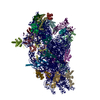





 PDBj
PDBj